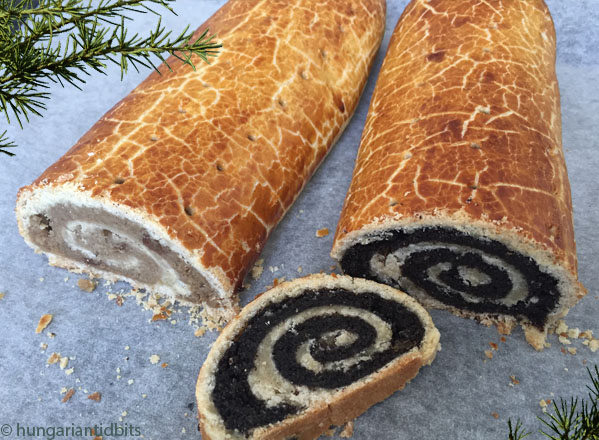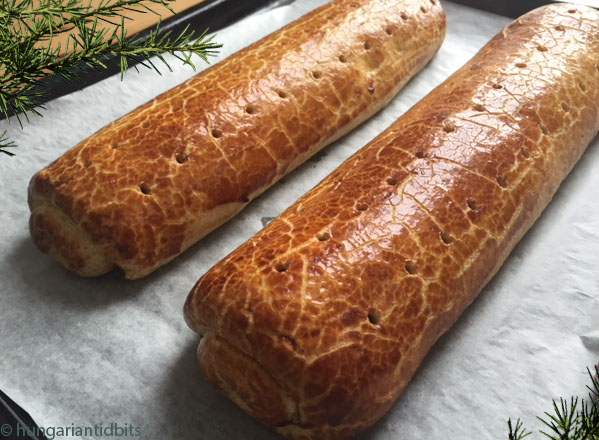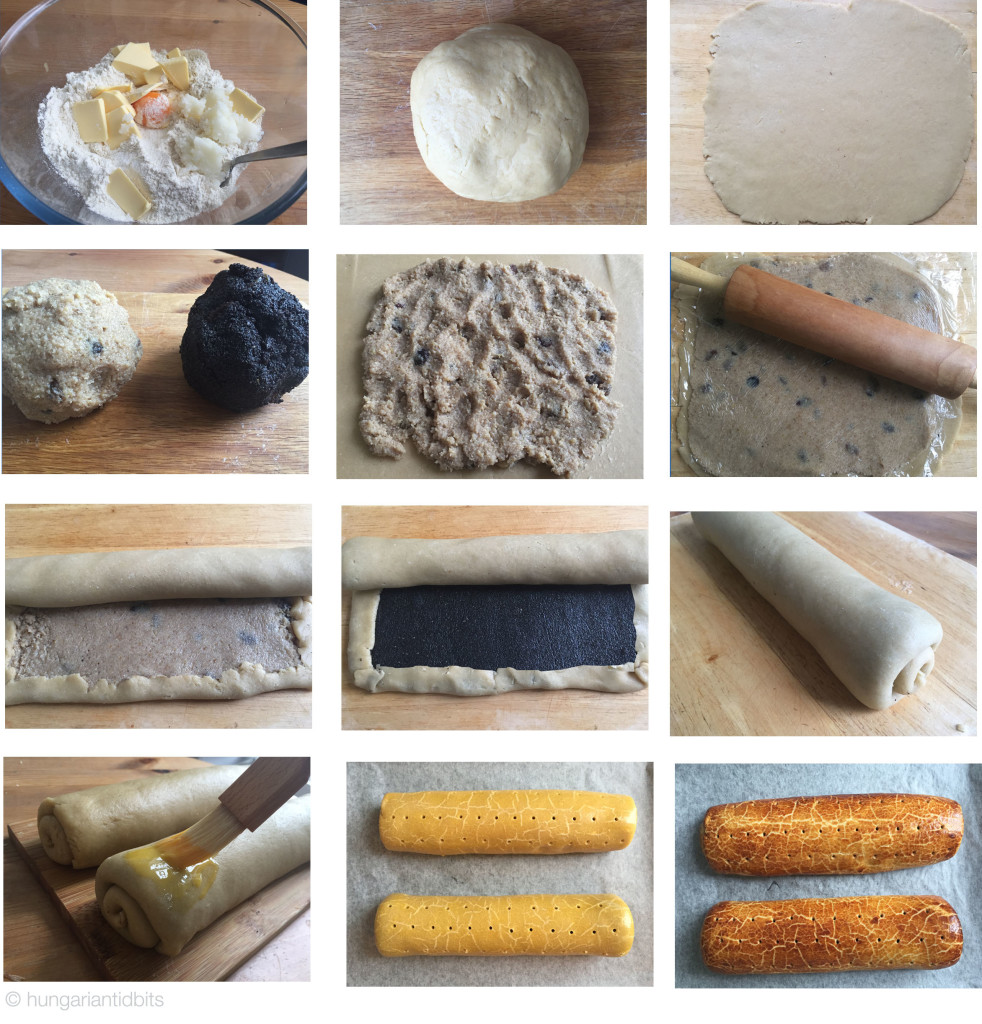

Christmas in Hungary is the most important holiday and amongst many things means a time for bejgli! Families are busy making their own and they are stack high in the shops and markets too. By far the most popular are the walnut and poppy-seed paste filled rolls. According to folk legend eating walnuts protects and keeps evil spells away while poppy-seed brings prosperity in the house. They taste delicious too, usually served with coffee after the family Christmas dinner.
Ingredients for the dough, makes 4 bejglis
- 600 g (21 oz / 5 cups) plain/all-purpose flour
- 170 g (3/4 cup, 1.5 sticks) margarine or butter
- 83 g (1/4 cup) pork fat (I used goose fat that I had and it turned out good, couldn’t detect in the taste)
- 70 g (0.6 cups) icing/powdered sugar
- 17 g fresh yeast (equivalent of 7g dry yeast / 5 g quick yeast)
- 7 g (1.5 teaspoon) salt
- 1 large egg yolk, or 2 small ones
- 67 ml (~1/4 cup) unsweetened whipping/pouring cream 30% fat content
- 133 ml (~1/2 cup) cold water or as much as the dough will take up, depending on flour type
- +1 egg for the egg wash before baking
Walnut OR Poppy-seed filling for 4 bejglis
- 570 g (20 oz) walnut or poppy-seed ground
- 330 g (1.6 cup) granulated sugar
- 100g (1 cup) breadcrumbs or sweet biscuit crumbs
- a handful of sultanas
- 2 level teaspoons of cinnamon
- 2 finely grated zest of unwaxed lemons
- tiny amount, half a pinch of toasted ground cloves
- 330 ml (1.17 cups) water
If you’d like 2 walnut and 2 poppy-seed bejglis then half the above ingredients for each.
The same spices and flavourings (cinnamon, lemon zest, sultanas etc) can be used for both walnut and poppyseed fillings.
Test the poppy-seed before investing in a bigger batch, they can easily oxidise which ruins the taste if not packaged/stored properly.
Assemble the filling
The consistency of the nut filling paste should be firm enough that it would hold it’s shape in a 270g (9.5oz) ball (that’s one portion), there is a picture of this below.
- in a saucepan add the sugar to the water and bring to boil, let the sugar dissolve
- pour onto the mixed dry ingredients, combine
- Cool it down completely, practical to make the filling a couple of hours or a day ahead
Let’s make bejgli!
From the above amount you will get 4 loaves at 500g/1.1lb weight each.
Once you made the dough you will need to measure out the four portions on a scale, making sure that each dough and filling weigh an equal, 270g/9.5oz.
As a heads up, it helps if the rolled, unbaked bejgli with the egg wash on rests and dries without cover for a few hours at a cool place like a pantry. You could also plan to make them up the day before baking, the next day just need to pierce a few times and bake.
- Combine all of the ingredients for the dough by hand or a processor, but hold back some of the cold water at the end. The yeast should be crumbled into the dough with the rest of the ingredients too, no need to activate separately. Also try to avoid the salt and yeast getting into direct contact much at the beginning, it doesn’t help the yeast.
- Work into a smooth not too soft dough, add as much of the water as needed, it depends how much your flour takes up. When rolling out a piece, it shouldn’t stick to the flat surface when rolling it up. Don’t use a floured surface when rolling, a flour dusted roll would prevent the eggwash to stick well and couldn’t create as much of a nice marbled effect. If the dough is too sticky, simply work in a little more flour until it can be rolled out without sticking.
- Once the desired consistency achieved, divide into four equal portions, wrap each in cling film/plastic wrap and refrigerate for about 20 minutes or up to an hour.
- After resting, measure the portions to be 270g/9.5oz each. Flatten by hand then roll out into an approximately 20cm x 25cm (8″x10″) rectangle. Tip, to avoid an oval pond shape roll from the middle towards each four corners.
- Place the filling on the sheet of dough and with wet hands flatten evenly spreading within 1/2 in. of edges. As an option, you could roll out the nut paste with a rolling pin on the top of the dough whilst covered with cling film/plastic wrap.
- Fold up the 1/2 in. dough edges on each side over the filling to prevent leaking, then tightly roll up lengthwise to form a roll, the seal to fall onto the bottom of the loaf.
- Repeat the rolling and filling for the rest of the portions.
- Now we get onto the egg wash which will create the marbled effect. Separate the egg and brush the bejglis all over with only the yolk, mixed with a few drops of water if needed. Let the egg yolk wash dry, it will take about half an hour or so. Now brush on the egg white, again combine with very little water for easier application, let it dry.
- Put the bejglis aside to slowly dry a bit, uncovered, at a cool place if possible, for an hour minimum or leave them overnight and bake the next day. Don’t refrigerate, they won’t be able to dry there. Drying helps the rustic look and creates firmer outer texture that bakes evenly without unexpected yeast activity or erupting fillings.
- Just before baking pierce the loaves evenly with a skewer or similar (knitting needle), making sure it goes all the way through. I did three rows, one in the centre and one on each side. It helps the steam escape that could cause the pastry to split.
- Line a baking sheet with parchment paper, transfer the bejglis and bake in a pre-heated, fan assisted oven at 180C, 350F for 25-30 minutes
- Let them cool on a wire rack



I make Poteca in fact made 4 loaves this week. I will try your recipe out soon, Thanks for posting it.
I must try Poteca sometime, they look delicious!
This has always been a Christmas tradition in our family, but I’ve never seen a recipe outside of my Mom and Grandma. Bejgli is delicious! Highly recommended
I follow this recipe and made walnut one first. Your saying that it should be 4 to be able to make 4, but 1 pastry was to thin and had to add 2 together. So didn’t end up making 4 only ended up with 2 walnut. And follow you measurements on rolling out the dough was very thin. Now I have to double the ingredients to make sure there is enough for the poppyseed 2.
Hi Veronika, Sorry to hear that you found the dough too thin. It should be quite thin though when rolled out and will get thicker from the yeast during baking. Also, I’m rolling each dough roughly into a 20cm x 25cm (8″x10″) sized rectangle as the recipe says, if rolled out bit bigger, they of course come out thinner, but this would still make a good result. Hope your bejglis came out nice and tasty at the end.
Hello– My family always made beijli for Christmas and Easter but in addition to walnut and poppy, we also made plum lekvar and cheese. I never knew the real name of them, just called them nut roll, plum/prune roll, cheese and poppy rolls. My family came to the USA 1928, and all our ancestors back to at least 1700s came from the very small part of Szatmar county (most of which is now Romania) that remains Hungarian. No one left recipes, they didn’t use them. The only recipe book I had was one my grandmother bought from a church. It included a few Hungarian as well as some Russian, German and Polish recipes. I guess the mix of that church’s congregation. I use that for aranygaluska–the walnut cake my grandmother always made , the “rolls” and the cookies filled with apricot, plum, walnut (kiflis?). The ones I make, I remember by heart like stuffed cabbage and fried cabbage and noodles
I’m not even sure I make them correctly anymore. It’s so nice to be able to check what I remember against your recipes and learn some new ones. I’m so glad I found this site. Thank you.
Where can one buy poppy seed?